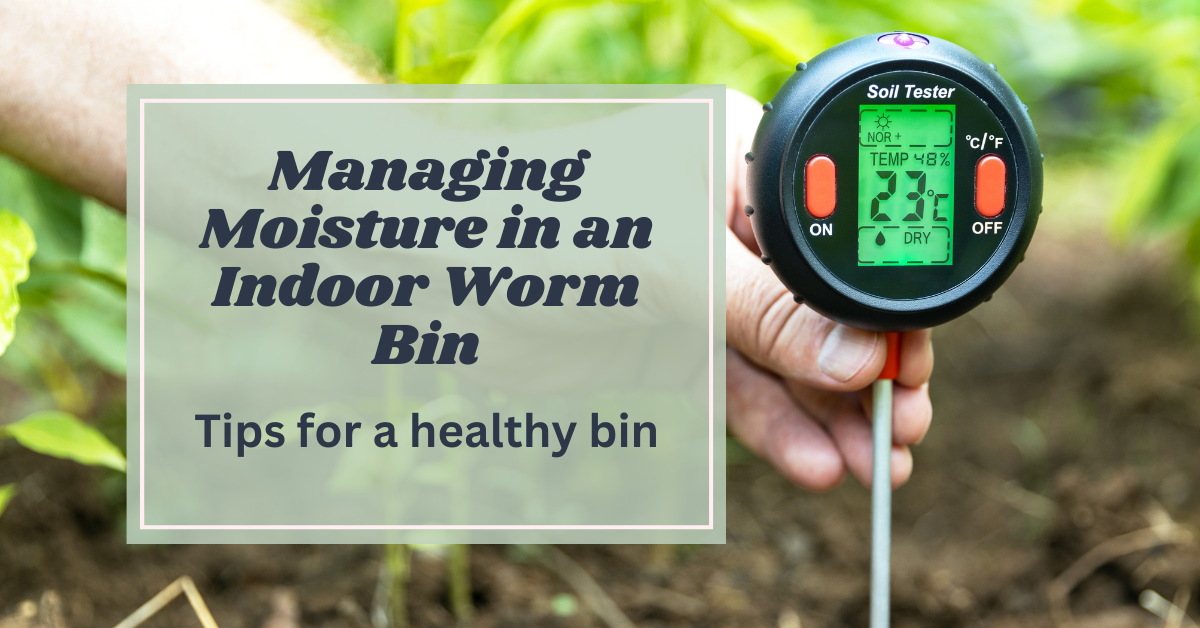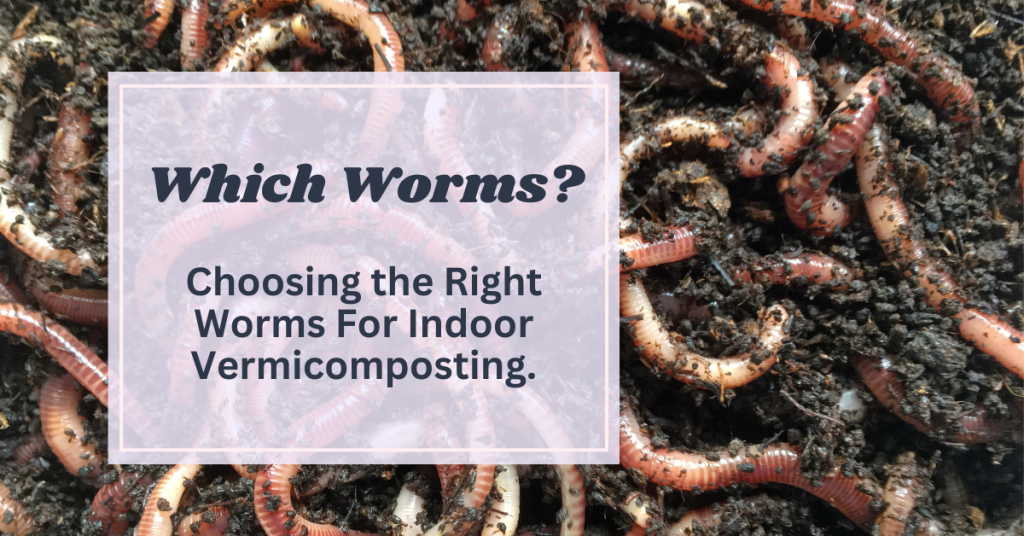Managing Moisture in an Indoor Worm Bin: Tips for a Healthy Bin
Please note that this post may contain affiliate links, which means we may earn a commission if you make a purchase through our links, at no extra cost to you. Learn more.
Maintaining the right moisture level is one of the most important factors in keeping an indoor worm bin healthy and productive. Too much or too little moisture can affect the worms’ ability to thrive and decompose your food scraps. When the moisture is just right, worms will work efficiently, breaking down organic matter and producing nutrient-rich castings.
In this post, we’ll explore why moisture is crucial to successful vermicomposting, how to determine if your bin has too much or too little moisture, and what you can do to maintain the ideal balance for a thriving indoor worm bin.
Why Moisture Matters in Vermicomposting
Moisture plays a vital role in the health and efficiency of an indoor worm bin. Worms breathe through their skin, and for them to take in oxygen, their environment needs to stay moist. If the bin becomes too dry, worms will struggle to breathe and may even die.
On the other hand, too much moisture creates an oxygen-deprived (anaerobic) environment, which can lead to bad smells and slow down the decomposition process.
In the right moisture conditions, the organic matter in the bin decomposes efficiently, producing valuable worm castings. When the bin stays balanced, the worms remain active, the breakdown of food scraps is fast, and the process runs smoothly.
Ideal Moisture Level for an Indoor Worm Bin
The ideal moisture level for an indoor worm bin should be comparable to a wrung-out sponge: damp but not dripping wet. This balance ensures that the environment remains moist enough for the worms to thrive, while also preventing issues associated with excessive moisture, such as bad smells.
Different indoor environments can affect moisture levels in your worm bin. Factors like room temperature, humidity, and heating can all impact how quickly moisture evaporates or accumulates.
To maintain the right moisture level, it’s helpful to check regularly and adjust as needed. You may find you have to adjust the ways you manage moisture levels in your worm bin depending on the season.
One effective method for checking moisture is the “squeeze test.” Take a small handful of bedding from the bin and squeeze it in your hand. If a few drops of water come out, the moisture level is likely too high. If the bedding feels dry and crumbly, it may need more moisture.
Ideally, the bedding should feel moist but not produce excess liquid when squeezed.
Signs of Too Much Moisture
Excess moisture in your worm bin can create several issues:
- Soggy Bedding: When the bedding becomes excessively wet, it can turn into a slimy mess. This condition not only disrupts the worms’ habitat but also leads to anaerobic conditions, which can cause foul odors.
- Bad Smells: An overly wet bin can produce sour or rotten smells, indicating that the bin’s environment has become anaerobic and is not processing waste efficiently.
- Worm Behavior: Worms may try to escape or appear sluggish if the environment is too wet. This behavior is a sign that they are uncomfortable with their surroundings.
Common causes of excess moisture include overwatering or misting too frequently, adding too many high-water-content food scraps (such as fruits), or poor airflow within the bin.
How to Fix a Wet Worm Bin
If your worm bin is too wet, you can take several steps to restore balance:
- Add Dry Bedding: Incorporate dry bedding materials like shredded paper, cardboard, or coconut coir to absorb the excess moisture. Mix these materials into the wet bedding to help even out the moisture levels.
- Improve Airflow: Enhance ventilation by adding more air holes to the bin or gently stirring the bedding to promote better air circulation. This is often referred to as “fluffing” the bedding and can be a good thing to do every once in awhile.
- Monitor Water-Rich Foods: Reduce the amount of food scraps with high water content, such as watermelon or cucumbers. Chop these items into smaller pieces to help them break down faster and reduce moisture buildup.
Signs of Too Little Moisture
A bin that is too dry can lead to:
- Dry, Crumbly Bedding: When the bedding lacks moisture, it becomes dry and difficult for worms to navigate. This condition can slow down the decomposition process.
- Slow Decomposition: A dry bin can cause food scraps to break down more slowly, leading to a backlog of unprocessed material, which could result in bad smells.
- Worm Behavior: Worms may appear sluggish or less active if the environment is too dry, which can negatively affect the composting process.
Dry conditions can result from overcompensating with dry bedding, high indoor temperatures, or low humidity levels. Both indoor heating and the use of air conditioners may dry out bedding, so just remember to keep an eye on things.
How to Fix a Dry Worm Bin
To address a dry worm bin, consider these adjustments:
- Lightly Mist the Bedding: Use a spray bottle to add a light mist of water to the bedding, ensuring it’s evenly damp without becoming soggy.
- Add Moist Bedding: When introducing new bedding, pre-moisten it before adding it to the bin. This approach helps maintain consistent moisture levels.
- Add Moisture-Rich Food Scraps: Introduce fruits and vegetables with high water content to help balance the moisture. Be sure to chop these scraps into smaller pieces for faster decomposition.
- Cover the Bin: Place a breathable cover or damp newspaper on top of the bedding to help retain moisture while allowing for adequate airflow.
Long-Term Moisture Management in Your Worm Bin
Maintaining proper moisture levels requires ongoing attention. Implement these practices to keep your worm bin in balance:
- Regular Checks: Make moisture level checks a part of your routine. Adjust as necessary based on the bin’s appearance and the condition of the bedding.
- Balanced Food Scraps: Add a mix of moist and dry food scraps to maintain equilibrium. Avoid large quantities of water-rich foods in one go.
- Consistent Bedding Maintenance: Rotate bedding and food scraps to ensure even distribution of moisture throughout the bin.
- Monitor Environmental Conditions: Be mindful of factors such as room temperature and humidity that can influence moisture levels in your bin.
Conclusion
Managing moisture in an indoor worm bin is essential for maintaining a healthy and efficient vermicomposting system. By understanding and addressing both excess and insufficient moisture, you can ensure a thriving environment for your worms and a productive composting process. Regular monitoring and adjustments will help keep your worm bin balanced and odor-free, making indoor vermicomposting a successful and rewarding endeavor.









